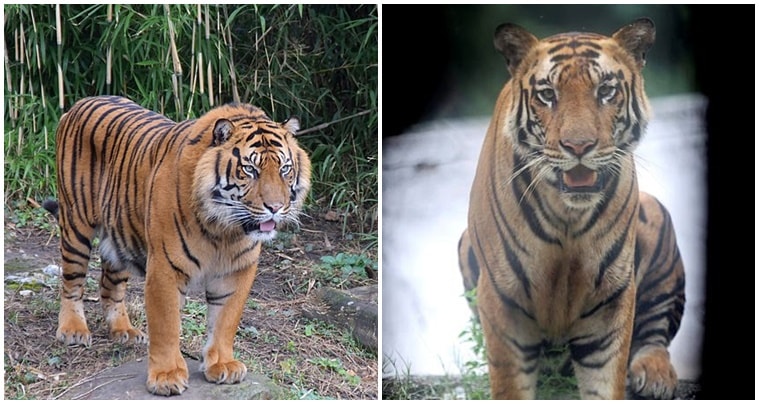Why some tigers from India may be sent to Cambodia
India is considering translocating some tigers to Cambodia. How did the tiger go extinct in Cambodia and why is it trying to reintroduce them from India?
 Tiger cubs with their mother, a white tigress, at a Punjab zoo. India harbours more than 70% of the global wild tiger population. (Express photo: Jaipal Singh)
Tiger cubs with their mother, a white tigress, at a Punjab zoo. India harbours more than 70% of the global wild tiger population. (Express photo: Jaipal Singh)After African Cheetahs were successfully translocated to India recently, the government is considering sending some tigers to Cambodia, where the big cat has gone extinct. As reported by The Indian Express, India signed a memorandum of understanding with Cambodia in November to assist it with “all technical details and knowledge’’ regarding the reintroduction of the tiger in the country.
How did the tiger go extinct in Cambodia and why is the country trying to reintroduce them from India?
How did tigers go extinct in Cambodia?
Due to habitat destruction and poaching. Tigers need large habitats to roam in and a significant prey base to hunt. As forests were cut down for development activities and as human habitats extended into forests, the tiger’s habitat came under stress. Smaller habitats meant more competition for prey, more inbreeding, and more human-animal conflict.
Also, tigers were killed for their valuable body parts. According to the World Wildlife Fund (WWF), “Every part of the tiger—from whisker to tail—has been found in illegal wildlife markets. A result of persistent demand, their bones, and other body parts are used for modern health tonics and folk remedies, and their skins are sought after as status symbols among some Asian cultures.”
The last tiger spotted on a camera trap in Cambodia was in 2007. In April 2016, Cambodia announced that tigers were “functionally extinct”, meaning no breeding populations of the animal were left in the country.
Why translocate from India?
As far back as 2016, Keo Omaliss, Cambodia’s director of the department of wildlife and biodiversity at the Forestry Administration, had been quoted as saying by the AFP that “we want two male tigers and five to six females tigers for the start”, and that “talks had begun with countries including India, Thailand and Malaysia” for this.
However, wildlife experts had then said that before reintroducing the animal, Cambodia needed to address the problems that had led to its extinction in the first place. Cambodia has since been making efforts to make its forests more hospitable for the big cat.
Thirteen countries make up the tiger range of the world — Bangladesh, Bhutan, China, Cambodia, India, Indonesia, Laos, Malaysia, Myanmar, Nepal, Russia, Thailand and Vietnam. In 2010, these countries had met and adopted a goal to double their tiger population by 2022. India reached the goal before that year, and, with its current population of about 3,000 tigers, harbours more than 70% of the global wild tiger population. The animal has gone extinct in Laos and Vietnam.
The Indochinese tiger found in Cambodia is smaller than the Royal Bengal tiger, but they are the same subspecies. According to the WWF, “since 2017, IUCN has recognised two tiger subspecies, commonly referred to as the continental tiger and the Sunda island tiger. All remaining island tigers are found only in Sumatra, with tigers in Java and Bali now extinct. These are popularly known as Sumatran tigers. The continental tigers currently include the Bengal, Malayan, Indochinese and Amur (Siberian) tiger populations, while the Caspian tiger is extinct in the wild. The South China tiger is believed to be functionally extinct.”
 The Sumatran tiger (left) is smaller than the continental tiger, and has a distinctive beard and mane. (Wikimedia Commons/Express photo by Gurmeet Singh)
The Sumatran tiger (left) is smaller than the continental tiger, and has a distinctive beard and mane. (Wikimedia Commons/Express photo by Gurmeet Singh)
India translocates tigers within the country, but has never done so internationally. Before the animals are sent to Cambodia, there are checks to be conducted. SP Yadav, member secretary, National Tiger Conservation Authority (NTCA), said, “We will have to look at many factors before taking a decision. To begin with, we have to verify whether the reasons for tiger disappearance in Cambodia have been addressed, whether they have the requisite facilities and infrastructure to support the tiger.”
What is Cambodia doing to reintroduce the tiger?
According to non-profit Wildlife Alliance which works in Cambodia, one of the possible sites of tiger reintroduction is the Cardamom Rainforest Landscape, which offers “a vast expanse of forest cover, grasslands, and wetlands that are ideal for tiger reintroduction. These protected areas include the Southern Cardamom National Park, Tatai Wildlife Sanctuary and Phnom Samkos Wildlife Sanctuary.”
In these areas, the Wildlife Alliance website says, an inviolate core zone of more than 2,000 sq km has been “created and secured”; three tiger prey base surveys have been conducted, “finding good tiger prey density”; more patrol rangers to prevent poaching are “strategically situated around the Tiger Core Zone”; and the local communities are being engaged in the conservation efforts.
A successful reintroduction of the tiger will not only mean increased tourism income for Cambodia, but also restore ecological balance by introducing an apex predator. Also, as WWF says, “Tigers are an umbrella species, which means when they are conserved, it also helps to conserve many other species. Tiger conservation brings the highest levels of protection for an area as well as an increase in funds and capacity.”
- 01
- 02
- 03
- 04
- 05






































